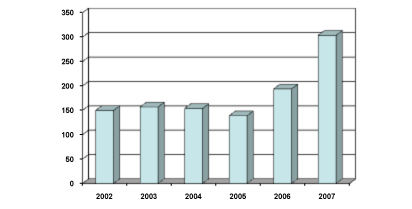December 2008 // Volume 46 // Number 6 // Ideas at Work // 6IAW3
Eastern Idaho Teens Learn Table Etiquette
Abstract
University of Idaho Extension Educators developed Manner Mishaps to teach teenagers skills for familial, social, and professional dinner settings. Through the use of PowerPoint® slides, demonstrations, the video Etiquette Hotline, and an interactive game, the students learned proper table settings and the use of tableware. Of the 1,086 participants, 97% agreed or strongly agreed that the program was interesting and that participating in the program would be helpful in their future. Student knowledge of etiquette rules and behaviors increased from an average of 65.9% on the pre-test to 95.0% after completing the course.
Introduction
With the current trend of business negotiations and job interviews being conducted over lunch or dinner, knowledge and practical application of table etiquette influence the outcome of these discussions. Opinions are formed by employers or business associates about potential employees based upon the skill at which they navigate their way through a business luncheon or dinner (Headley, 2007). Objectionable table manners in these professional settings can destroy a potential employer's impression and can halt a business proposal (Casperson, 2001). A lack of knowledge and skill in the area of table manners has prompted many colleges and universities to provide refresher courses in table etiquette as part of their training for careers (Feldhues, 2008; Cole, 2002; Neff 1999).
After observing the mealtime behavior of junior high and high school students in eastern Idaho, Family and Consumer Sciences teachers recognized the need for instruction in the area of table manners (Hanken & Sachs, 2004) and asked Extension educators to develop a program on table etiquette. When a query of the Extension Family Development national network revealed no other programs designed for the school classroom setting, we developed a program to teach youth table etiquette.
Program Description
Manner Mishaps focuses on table etiquette for a target audience of teenagers, using an interactive method so table etiquette skills can be both understood and applied. Through the use of PowerPoint® slides, the students learn how to set a table properly by adding one piece of tableware at a time. With demonstration and personal examples, the students learn which piece of silverware to use for each part of the meal, how to eat different types of food, and the proper use of a napkin and tableware. In a humorous way the video Etiquette Hotline illustrates poor table etiquette and allows students to become aware of their own appearance when dining.
A game similar to Jeopardy® is an interactive method to reinforce the material and allows the instructor to determine if the information was understood and assimilated. The game board is projected using PowerPoint® slides and includes a Daily Double question as well as Final Jeopardy®. The students are divided into two teams and take turns answering the questions by being the first one to respond. The classroom teacher serves as the scorekeeper.
If time permits, students demonstrate their knowledge and practice their skill by setting the table for a student-determined menu representing a breakfast, lunch, or dinner. At the conclusion of the class, the students are rewarded for a completed evaluation with a Snickers® candy bar as a reminder to know their table manners so no one will snicker at them. Teachers reinforce this material by incorporating table etiquette during future classroom meals.
This program is presented in four 20-minute segments, making it easily adaptable to a variety of classroom setting from 45-minute classes on the junior high level to 1 1/2- settings at alternative high schools. There have been 10 students in the smallest classes and 32 students in the largest class. This program has been offered in Family and Consumer Science classes, career development classes, and at 4-H clubs during preparations for visits to the legislature. Program growth over the years (Figure 1) shows the enthusiasm for the program among area teachers.
Figure 1.
Number of Participants

Program Outcomes and Evaluations
Students responded to 10 true-false questions administered at the beginning and at the end of the program in order to determine changes in knowledge. Of the 1,098 students who participated in the program between 2002 and 2007, 1,086 students completed both a pre- and post-test of questions on basic table etiquette, including mealtime behavior and silverware and napkin use. On average, test scores improved from 65.9 % correct on the pre-test to 95 % correct on the post-test. The evaluation also revealed 97% agreed or strongly agreed that the program was interesting and that participating in the program would be helpful in their future. In sum, evaluation data shows that Manner Mishaps teaches skills of etiquette that can help youth in social or work settings.
References
Casperson, D. (2001). Mastering the business meal. Training and development, March, 68-69.
Cole, K. (2002). Miss manners? Etiquette dinner gives students a refresher course. George Street Journal 2, Retrieved December 3, 2008 from: http://www.brown.edu/Administration/George_Street_Journal/vol26/26GSJ16c.html
Feldhues, N. (2008) Career Center: Dining etiquette. Ball State University Education Redefined. Retrieved October 20, 2008 from: http://www.bsu.edu/students/careers/students/interviewing/dining/
Hanken, C., & R. Sachs. (2004). Etiquette on the menu. American School Board Journal. 74-75.
Headley, C. (2007). Keeping your elbows off your career table. Nephrology Nursing Journal, 43, 3, 357-358.
Neff, N. (1999). The fork in the road: Author schools UT students on importance of proper dining etiquette in landing jobs. On Campus: The University of Texas at Austin. 27, 6, Retrieved September 15, 2008 from: http://www.utexas.edu/opa/pubs/oncampus/990c_issues/oc991109
